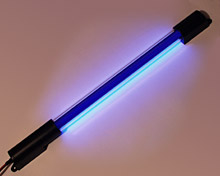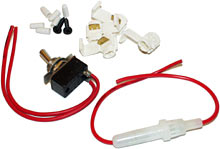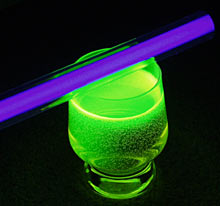
CaseETC PC blacklight and UV fluorescent coolant dye
Review date: 28 June 2001. Last modified 03-Dec-2011.
Welcome back to the Dan's Data Tale Of Woe Half-Hour. Today: How I didn't quite finish reviewing some ultraviolet toys.
You see, CaseETC were good enough to send me...
...this. Ten inch blacklight, modified computer cases for the illumination of, one. $US29.99.
They also sent me...
...this. Dye, water cooled computer coolant for the decoration of, one fluid ounce (about 30cc). $US14.99.
The dye fluoresces under ultraviolet light, which is what the blacklight emits. Put a few drops of the dye into your coolant - because a little goes a long way - and install the blacklight in your case, and your see-through coolant tubing glows spooky green.
The light wasn't a problem.
The dye was.
So let's talk about the light first, shall we?
Lighting up
Ten inches - about 25cm - is the length of the light-emitting middle part of this fluorescent tube. The overall length of the light is about 15.75 inches (40cm), plus a little more for the screw tabs sticking out at the ends. If you mount the tube with double-sided tape - which is the way to go, in a PC case - you can cut off the tabs.
This is a 12 volt lamp. It's got step-up hardware built in that lets the tube run from 12 volts DC. So you can just connect it directly to any 12 volt power supply. Like, for instance, the 12 volt line from your computer PSU.
The tube is obviously made as a car decoration. Well, all 12 volt neon products are made as car decorations, really, but this one's in its original packaging and comes with its original connection hardware, so its intended purpose is unusually apparent.
Here's what you get, besides the tube itself. There are four solder-free wire-splicers you clamp together with pliers; they'd probably work OK on a computer's PSU wires. The tube itself just has a plain unterminated figure-eight cable coming out of it.
There are also some plastic crimp-on wire end-caps, a couple of self-tapping mounting screws, a pre-wired switch, and a pre-wired in-line fuseholder with a one amp fast blow fuse in it. You could botch this setup together with nothing but pliers, but you'd really want to do some soldering to get it looking nice.
The package also contains somewhat tortuously worded instructions for installing the tube in a car. Installing it in a computer isn't the most difficult feat in history, and any vaguely competent electronics hobbyist could figure it out. But this is not a plug-and-go solution.
The next step up from CaseETC are their more computer-specific "Neon Light Kits", but they're still do-it-yourself. You just get more appropriate connectors, some heat shrink tubing, and double sided tape. BYO soldering iron.
If you can't quite handle that, then for a bit more money they'll do you a full "Premade Light Kit", with everything connected up for you.
Getting back to the blacklight - hooked up to 12 volts, it draws about a quarter of an amp, so it's a three watt unit. That's not exactly monster light power.
You can get Compact Fluorescent Lamp (CFL) blacklights now (Aussies can buy them from Jaycar) that have 15 and 26 watt ratings. You can also get ordinary straight blacklight tubes that fit in standard two and four foot fittings, and have the same 20 and 40 watt ratings as normal fluoros for the same fittings.
Incandescent "blacklight" globes, by the way, aren't much use. They have a hot filament in them (with maybe a 500 hour lifespan...) and a purple coating inside which lets through longer UVA wavelengths, and a fair amount of non-UV light as well. They run hot, and their efficiency is lousy, because even a hot incandescent filament doesn't emit a whole lot of UV.
Herewith, a brief diversion on the subject of what, exactly, this "UV" thing is, and why you don't have to worry about getting skin cancer in discos.
"Blacklight" lamps don't emit any dangerous ultraviolet radiation to speak of, unless you're taking some drug that increases your sensitivity to mild UV exposure. If a normal person not on any such drugs spends all day staring at a high-powered blacklight, they might eventually suffer eye damage.
So don't do that.
The UV output of these sorts of lamps is in the "near ultraviolet", spilling over into the visible spectrum. The light is in the "UVA" band, which has wavelengths of 400 to 315 nanometers (nm). The shortest wavelength humans can see is, canonically, about 400nm. If blacklights emitted nothing above 400nm then they'd seem to be a very dim violet; they actually emit a reasonable amount of visible blue light as well, which is why you can easily see whether they're on or off, as long as you're not somewhere brightly lit. The shorter the wavelength, the higher the energy. The higher the energy, the more damage UV can do.
The shorter UVA wavelengths have enough energy to give you a suntan, followed by sunburn. And possibly, eventually, skin cancer. But you're not likely to get anything below about 350nm from a "disco light" sort of blacklight. The shorter end of the UVA spectrum's emitted by the safer (but still not safe) kind of tanning bed lights.
Almost 99 per cent of the UV in sunlight is UVA. The remainder is UVB, which is 315 to 280nm. That's what gives you a normal suntan, and sunburn too if you hang about long enough for your skin's melanin level to be insufficient. UVB exposure also, of course, gives you a much better chance of getting skin cancer.
Ozone layer degradation increases the amount of UVB that gets through to the planet's surface. But if you just can't wait, seal yourself into the nastier kind of tanning bed and you'll get plenty.
UVC is 280 to 100nm, and is rather more ferocious again, if it actually manages to get to living cells. UVC from the sun is all blocked by a large enough amount of atmosphere (oxygen and nitrogen absorb it; ozone isn't needed) so you don't get any of it from sunlight. But it's not a good idea to spend time near another UVC source like, for instance, an unshielded electric arc. The dead cells on the surface of your skin will block some amount of UVC, but they won't get all of it. And you don't have dead skin cells over your eyes.
UVC, and even shorter wavelengths, are used to erase EPROMs, and as "germicidal" UV. This light doesn't penetrate far into most substances, but you can use it to kill bacteria in water or on surfaces without having to heat things up or use antiseptics.
Getting back to blacklights and their risks - if you work in a disco or haunted house or some other place full of blacklight fluorescents, a pair of UV-blocking glasses might be a prudent idea. If you don't, then don't worry about it.
If you want UV-blocking glasses, then pretty much anything with glass lenses will do a decent job. All of the UV wavelengths from short-UVA to short-UVC are blocked by ordinary glass. That's why you can't get a suntan worth noticing if you sunbathe in light that comes through your picture window. But you can lie there all day without greatly increasing your risk of skin cancer, either.
Ordinary household fluorescent tubes are mercury vapour discharge lamps. They contain a couple of drops of mercury in a fairly hard vacuum; the mercury thus boils off into vapour, and can be excited by an electrical field into emitting quite hard and nasty 253.7nm UVC light. Functionally none of that light makes it out of the lamp, because the tube is coated on the inside with a phosphor layer that converts the UV into harmless and useful visible wavelengths.
Blacklight fluoros work the same way, but they've got a different phosphor coating, which absorbs the UVC and spits out mainly UVA. There are several different blacklight phosphors, but their UV output is generally around 350 to 370nm - quite safe, in other words. The tubes are made out of dyed "Wood's glass" to block most of the rest of the light the phosphor emits, and lets through. If you want to see what a blacklight tube made out of ordinary transparent glass looks like, have a look at a "bug zapper".
So that's the lamp. Anybody with basic wire-wrangling skills could install it in any PC case big enough to take it. But unless you've got something inside the case that'll fluoresce under UVA illumination, there's not much point.
Enter the dye.
Dye, dammit
CaseETC sell blue/white, blue, and green fluorescent dyes.
The green stuff they sent me doesn't look green, as it sits there, ultra-concentrated, in the tube. It looks orange. But if you add a few drops of the dye to some water, it swirls out into tendrils of authentic Springfield Nuclear Power Plant green-ness. A small stir will give you a very large amount of green water from a surprisingly small amount of dye.
CaseETC say 1/30th of an ounce (about 1cc) is enough to make a gallon (3.8 litres) of coolant glow, and they're not kidding. Most PC water cooling systems won't have more than a litre of water in them, if that.
Even without UV light, this stuff looks pretty darn green, especially in higher concentrations. It's got a peculiar gradient-greenness look about it, sitting there in a glass; hold it by a bright light and there'll be a green glow only in the liquid closest to the light.
Give it some UV light, though...
...and you get the full Predator-blood look.
Everything was going simply swimmingly, and it was time to test the dye in a real cooling system.
Until I knocked the glass dye vial off the table it was lying on, and it fell onto the carpeted floor.
It broke.
On the carpeted floor.
Don't ask me how. Splash went the dye, onto the carpet and onto my leg.
I wasted some valuable cleanup time by cursing.
Then I tried pouring water on the dye - turning the dark orange concentrate blotches into much larger electric-green diluted blotches - and mopping it up with toilet paper. This was pretty much a complete waste of time, but it did allow me to turn my hands orange.
Then I remembered that the cheap carpet in my ultracyberpunk testing room is actually carpet tiles. Hurrah.
I removed the tile with almost all of the stain on it, took it to the bathroom, and rinsed it.
And rinsed it and rinsed it and rinsed it and rinsed it and rinsed it and rinsed it and rinsed it.
This stuff washes out in water (it took soap and water to de-orange-ise my hands, but that's a quibble). What's amazing is how long it takes to do it. The water just keeps on coming off green.
After using up all of the hot water in the quite large hot water cylinder on the carpet tile and the leg of my jeans, there was obviously still dye there.
I began to surmise that the dye molecules were breeding.
I gave my jeans a washing machine all to themselves, and that seems to have solved that problem. And, after a bit of focussed squirting and then drying on the washing line, the carpet tile looks pretty much normal. Since, blessedly, the carpet is itself green.
I connected the blacklight to a 12 volt battery and waved it around the tile as it hung on the line, and it still fluoresces noticeably, but not very brightly. The dye does not appear to be as glow-y when it's soaked into fabric as when it's floating free in water.
On the plus side, this event at least gave me a reason to behave in a very odd way.
You're my neighbour, OK?
You are awakened by a string of curses, then some thumping and bashing and more curses, then a lot of water being run in my bathroom.
Then a figure with a strange blue-white light in its mouth comes out of the house with a dripping square of something and hangs it on the clothes line with lots of pegs.
Then the figure collects a pressurised sprayer and squirts the square with a foamy substance, then rinses it off.
Then the figure vanishes for a while, and comes back with a black rectangle connected to a UV light. It carefully scrutinises the square with the UV light, revealing significant green fluorescence on the square, and on the ground under it, and on the stream of drips falling from it.
And then, with the UV light brightly illuminating nothing but the mysterious white RTFM logo on its chest, the figure stomps away again.
Did I mention that all this was happening at two in the morning?
Well, it was.
Overall
What can you take away from this, apart from the knowledge that my neighbours now think I'm running an abbatoir for things with green glowing blood?
Well, the CaseETC coolant dye is The Business. If you need water dye that glows in UV light, they have it. And it is powerful stuff. Just treat the apparently strong vial with respect, won't you?
The CaseETC UV lamp, on the other hand, is OK but not amazing. Three watts just isn't a lot of light.
In a normally lit room, this lamp won't let you see a whole lot of fluorescence, even from highly fluorescent things that are right next to the tube.
In the dark, a computer full of fluorescent stuff will look groovy if it's got a window in the side and you light it from the inside with one of these tubes. But if you want your funkalicious computer mod to look good when it's light enough to read, then a table lamp with a blacklight compact fluoro in it will give you considerably more impressive results.
People who are comfortable with mains wiring - if you're wondering whether you are, then don't try it - could install a compact fluoro in a computer case easily enough. Surface mount socket, parallel wired with the PSU, bingo. Tower cases could hold a two foot mains fitting easily.
The ballast for these lights might cause problems with a PC; I don't know. If it doesn't, then it'd be a good solution.
Otherwise, more than one of the low power 12 volt tubes might be OK, but that'd get a bit expensive, and be awkward to install.
As it stands, the CaseETC blacklights are still nifty. But they only really work well if you do it in the dark.
If you're wondering what "it" might be - ask my neighbours.





